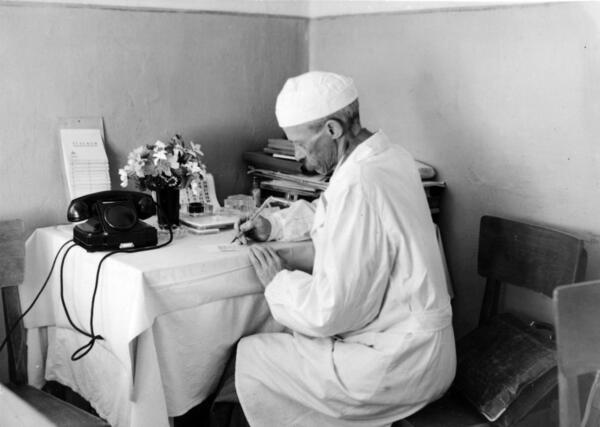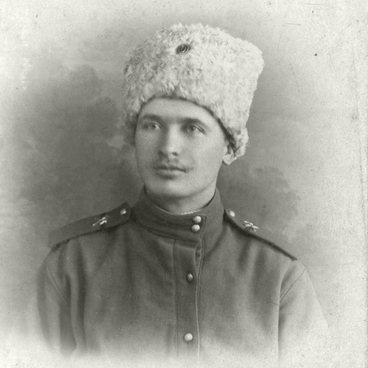The 1950 photo shows tuberculosis specialist VitAly KlyarOvsky’s office at the VelIkiye LUki Regional Tuberculosis Dispensary. Behind the doctor’s back we can see the chair of the therapist’s office; on the table there is a telephone that served the entire dispensary.
Vitaly Klyarovsky was born into the family of a clergyman in Velikiye Luki on April 19, 1892. After four classes at the Velikiye Luki Theological School, he transferred to the Pskov Theological Seminary. In May 1916, he graduated medical school with the title of Physician with Honors. It was at the height of World War One.
Vitaly Klyarovsky was born into the family of a clergyman in Velikiye Luki on April 19, 1892. After four classes at the Velikiye Luki Theological School, he transferred to the Pskov Theological Seminary. In May 1916, he graduated medical school with the title of Physician with Honors. It was at the height of World War One.
Klyarovsky was mobilized into the army and appointed junior doctor of the 65th Infantry Reserve Regiment in the city of MorshAnsk of the former TambOv Governorate. He worked there for 5.5 years.
In October 1921 the doctor left for the Karelian Front. In November of the same year, he was appointed head of the medical and sanitary department of the Sanitary Directorate of the Karelia district by the front command. The harsh northern winter ended badly for Klyarovsky: he developed pulmonary tuberculosis. At the end of May 1922 he was demobilized, returned to his homeland in Velikiye Luki and was treated at home for more than six months.
In 1923, he began to get acquainted with the urban “new medical world”, but there were no vacancies in the city’s institutions at that time. In the district the situation was even more difficult, a lot of medical workers were required, and Klyarovsky moved to a remote area, the village of Losevo, 40 km from the city. There were no doctors there before.
Klyarovsky did not work in Losev for a long time. In May, he received a letter from fellow alumnus Ivan Kudrinsky with an offer to work in the organization of medical care at the Velikiye Luki railway junction, and became the head of the 28th medical section at Velikiye Luki station. Here he fulfilled his old dream: he began to treat tuberculosis.
At that time, the treatment of tuberculosis was in its infancy. In the spring of 1925, Klyarovsky was sent to a specialization course in tuberculosis in Leningrad. For four months he studied at the clinics of the Institute for Advanced Medical Education and the Central Tuberculosis Institute, and after that he worked continuously in this field.
At this time, surgical treatment of tuberculosis began to be used with very effective results. Klyarovsky mastered this method and first applied it at the Velikiye Luki railway hospital, where he worked as an intern after returning from the courses. In the summer of 1927, he organized a tuberculosis dispensary and a night sanatorium with 30 beds. In 1928, the city became a district city, and the volume of work increased. By 1940, the dispensary’s staff had expanded significantly and a new building was needed. World War II hindered these plans. The entire staff of the former dispensary was evacuated to Krasny Kholm.
In 1945 Klyarovsky received a telegram with an order to return to his original place of work in Velikiye Luki. Of the hospital campus, only a three-story hospital and the two-story building of the physiotherapy department remained. Klyarovsky was appointed head physician of the regional tuberculosis dispensary, where he worked in the small office No. 3 on the first floor.
In October 1921 the doctor left for the Karelian Front. In November of the same year, he was appointed head of the medical and sanitary department of the Sanitary Directorate of the Karelia district by the front command. The harsh northern winter ended badly for Klyarovsky: he developed pulmonary tuberculosis. At the end of May 1922 he was demobilized, returned to his homeland in Velikiye Luki and was treated at home for more than six months.
In 1923, he began to get acquainted with the urban “new medical world”, but there were no vacancies in the city’s institutions at that time. In the district the situation was even more difficult, a lot of medical workers were required, and Klyarovsky moved to a remote area, the village of Losevo, 40 km from the city. There were no doctors there before.
Klyarovsky did not work in Losev for a long time. In May, he received a letter from fellow alumnus Ivan Kudrinsky with an offer to work in the organization of medical care at the Velikiye Luki railway junction, and became the head of the 28th medical section at Velikiye Luki station. Here he fulfilled his old dream: he began to treat tuberculosis.
At that time, the treatment of tuberculosis was in its infancy. In the spring of 1925, Klyarovsky was sent to a specialization course in tuberculosis in Leningrad. For four months he studied at the clinics of the Institute for Advanced Medical Education and the Central Tuberculosis Institute, and after that he worked continuously in this field.
At this time, surgical treatment of tuberculosis began to be used with very effective results. Klyarovsky mastered this method and first applied it at the Velikiye Luki railway hospital, where he worked as an intern after returning from the courses. In the summer of 1927, he organized a tuberculosis dispensary and a night sanatorium with 30 beds. In 1928, the city became a district city, and the volume of work increased. By 1940, the dispensary’s staff had expanded significantly and a new building was needed. World War II hindered these plans. The entire staff of the former dispensary was evacuated to Krasny Kholm.
In 1945 Klyarovsky received a telegram with an order to return to his original place of work in Velikiye Luki. Of the hospital campus, only a three-story hospital and the two-story building of the physiotherapy department remained. Klyarovsky was appointed head physician of the regional tuberculosis dispensary, where he worked in the small office No. 3 on the first floor.



